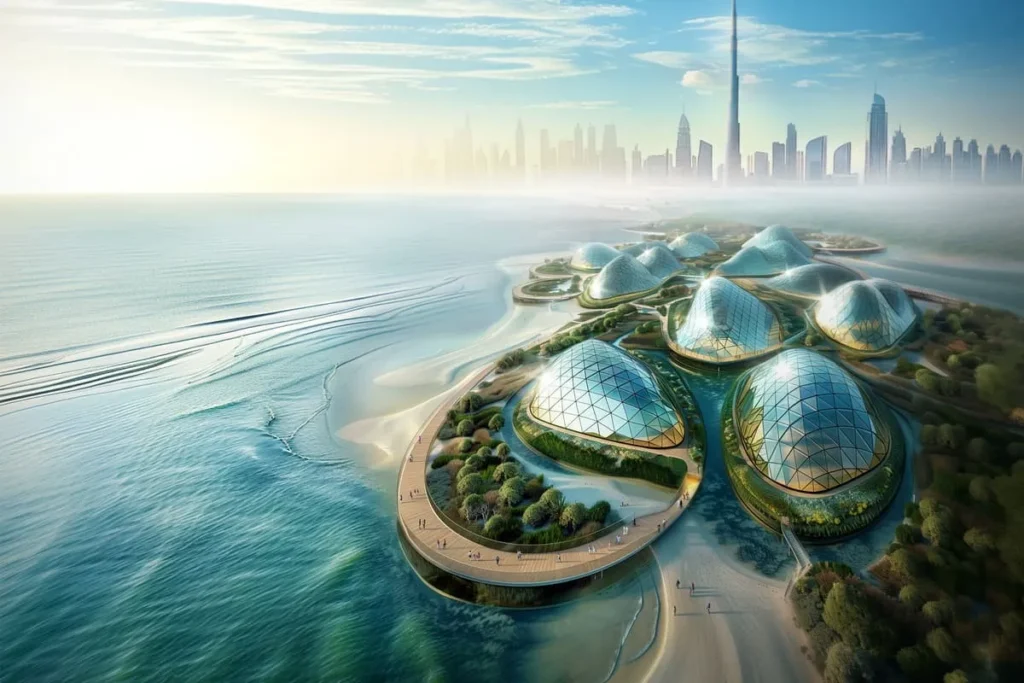Dubai, renowned for its architectural marvels and cosmopolitan lifestyle, is now set to undergo a green transformation along its coastline. The ambitious ‘Dubai Mangroves’ project, unveiled this week, aims to blanket the Emirate’s sandy shores with lush greenery, with plans to plant over 100 million mangrove trees across 72 kilometers of coastline. Let’s delve into the details of this groundbreaking initiative.

Vision and Development
Led by Dubai-based sustainable cities developer URB, the Dubai Mangroves project is envisioned to be completed by 2040 in six meticulously planned phases. The project aims to not only enhance the ecological diversity of the region but also provide recreational and educational opportunities for residents and tourists alike.
Innovative Features
Renderings released by URB showcase a plethora of features, including boardwalks traversing through mangrove forests, biospheres, pocket beach parks, and social spaces. Additionally, the project incorporates edutainment elements such as a visitor hub, botanical museum, and nature reserve conservation center, offering visitors insights into the significance of mangrove ecosystems and conservation efforts.
Pilot Locations
The project has identified six pilot locations, including popular beaches like Jebel Ali, Dubai Marina, and Jumeirah Public Beach, among others. These sites will serve as testing grounds for various coastal regeneration methods, ensuring adaptability to diverse local conditions.
Environmental Impact and Benefits
Apart from enhancing the aesthetic appeal of Dubai’s coastline, the mangrove forests are expected to play a crucial role in fortifying coastal defenses against rising sea levels. Moreover, the project aims to create a thriving habitat for numerous species of flora and fauna, thereby promoting biodiversity and ecosystem resilience.
Funding and Collaboration
URB plans to explore a mix of funding sources for the project, including sponsorships, investment in carbon credits, and participation in environmental education initiatives. While collaborations with businesses and private entities are being considered, the focus currently lies on conducting feasibility studies and seeking government approvals.
Innovative Technologies
The implementation of cutting-edge technologies such as drones and artificial intelligence is poised to revolutionize mangrove restoration efforts. Drones equipped with seed-planting capabilities, coupled with satellite imagery and AI-driven analytics, will facilitate efficient tracking and restoration of mangrove habitats.
Carbon Sequestration Potential
One of the most significant aspects of the Dubai Mangroves project is its potential to sequester carbon dioxide. With mangroves known for their carbon-absorbing capabilities, the project could annually sequester 1.23 million tonnes of CO2, significantly contributing to climate change mitigation efforts.
Continued Sustainability Initiatives
The Dubai Mangroves project is just one among several sustainability initiatives spearheaded by URB. Plans for a sustainable floating community called Dubai Reefs and a climate-controlled cycle highway known as ‘The Loop’ underscore Dubai’s commitment to environmental stewardship and innovative urban planning.
As Dubai embarks on this transformative journey towards a greener future, the Dubai Mangroves project stands as a testament to the Emirate’s vision of sustainable development and environmental conservation. With careful planning, innovative technologies, and collaborative efforts, Dubai is poised to set new benchmarks in urban sustainability and ecological resilience.
